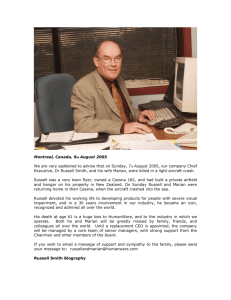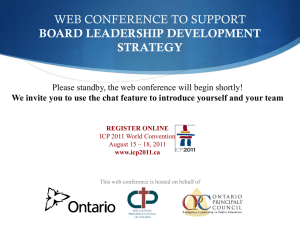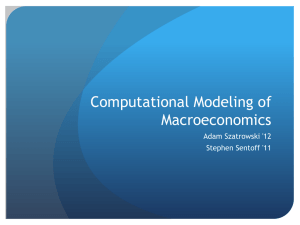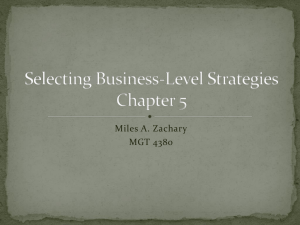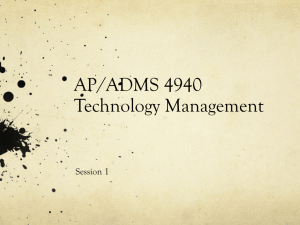Chapter 4
advertisement
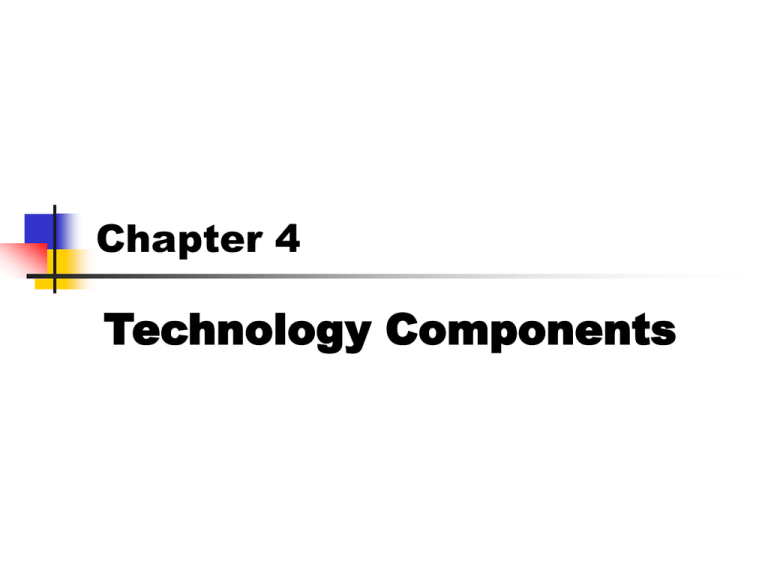
Chapter 4 Technology Components Chapter Objectives What are the technology components that firms should develop? How to assess those components? What are the interrelation between each components? 2 I-Process Technology 1. 2. 3. 4. There are four distinctive embodiment forms of function-specific technology: The object-embodied component of Technology “Technoware” The human embodied component of technology “Humanware” The institution embodied component of technology “Orgaware” The document embodied component of technology “Inforware” 3 Technoware Object-embodied physical facilities, such as: devices; equipment; machinery; structures—called Technoware —which enhance human physical powers and controls for all necessary transformation operations. 4 Humanware Person-embodied human abilities, such as: skills; knowledge; expertise; creativity —called Humanware—which contribute to actual utilization of available natural and technological resources for productive purposes; 5 Orgaware Institution-embodied organizational frameworks, such as: methods; techniques; networks; practices—called Orgaware— which coordinate all productive activities of the enterprise for achieving purposeful results. 6 Inforware Record-embodied documented facts, such as: design parameters; specifications; blueprints; maintenance and service manuals— called Inforware—which enable quick learning and help time and resource savings; These four components of technology provide a dynamically interacting base for transformation of inputs to outputs. 7 Major Critical for Assessing Technology Component Since technological sophistication is essential for competition, assessing the gap of the four technology components indicate the strength and weakness of an enterprise. Criteria for assessing technoware position Criteria for assessment may include: scale of operation, scope of outputs, quality of outputs, and safety or environmental soundness of operation. 8 Criteria for assessing humanware position relative to best practice may include: Criteria for assessing inforware position may include: level of general education (knowledge intensity); appropriateness of training and retraining, relevant experience, and motivation of the personnel. relevance (value), timeliness and reliability. Criteria for assessing orgaware position may include: market performance (policy, strategies ), and technological capability expansion 9 II-Product Technology Product technology consist of two major categories: Product design inforware Design foundation inforware Design specifications inforware Product usage inforware Product Operating inforware (POI) Product Maintenance (PMI) Product performance enhancing inforware (PPI) 10 Design Foundation Inforware (DFI) Information that provides into: the functional requirements of the product design; design concepts, simulation techniques and analytical procedure needed for understanding and predicting product performance and and customer needs (Used CAD). Design Specification inforware (DSI) Information such as engineering drawings of the product; design specifications; and design calculations used. 11 Product operating inforware (POI) Information such as standard operating procedures and information for installing the product. Product maintenance inforware (PMI) Information needed to maintain, repair and service the product. This include maintenance manuals (for both hardware and software), and troubleshooting checklist. Product performance enhancing inforware (PPI) Knowledge, that involves information needed for operation optimization, and upgrading product performance. 12 III-Conclusion Process technology maybe defined as manifestation of four elementary and interacting components namely: an object-embodied form called technoware; a human embodied form called humanware; and information embodied form called inforware; and an institution embodied form called orgaware. These four components are complementary to another and are interrelated. They are required simultaneously in a manufacturing operation and no transformation can take place in complete absence of any of the four components. 13 Technoware, in any manufacturing technology, is installed operated and improved by humanware. Humanware is the most valuable component of technology. Without the humanware, even if technoware is available. The manufacturing facility cannot be used. The effective use of technoware and humanware to facilitate desired value addition activities is the key role of orgaware. Good quality inforware is needed to improve the utilization of technoware by humanware. In turn good quality humanware can facilitate the refinement and development of inforware. 14 In the case of production technology, firms may either develop it themselves or buy it from other companies through technology transfer. 1. A firms that acts as dealer for product(s) of another may be interested only in buying product usage technology. 2. A firms that is strong in manufacturing may be interested in obtaining only product design technology based on a licensing arrangement. 15 Discussion Questions In your opinion, what are some important criteria which the firms should take to increase the quality and productivity of their products and service? 16
